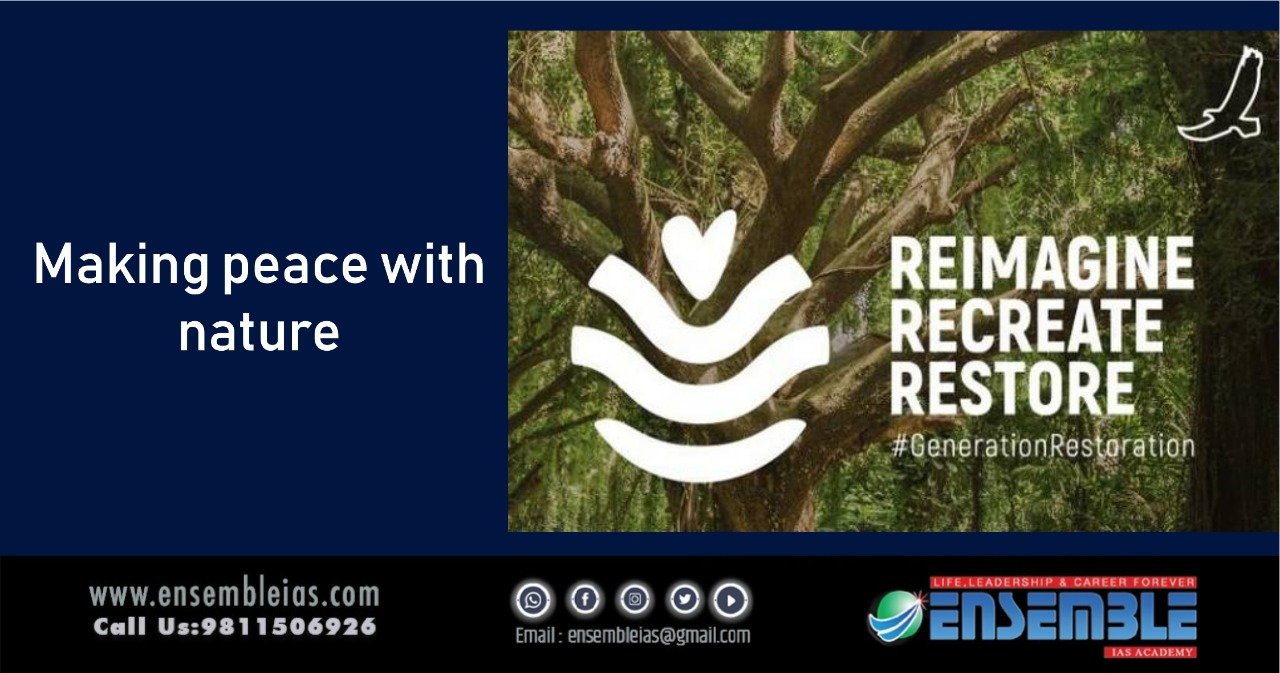Making peace with nature
Making peace with nature: A decade of protecting and reviving the ecosystem will help India in various ways
To buy our online courses: Click Here
There has never been a more urgent need to restore damaged ecosystems. The COVID-19 pandemic is a direct result of the degradation of natural areas, species loss, and exploitation. Zoonotic pathogens are more frequently jumping from wildlife to humans, creating public health emergencies. Healthier ecosystems and a healthier respect for the wild spaces of our world will give us a healthier planet and healthier people.
It is time to change how we cultivate our land, use our soils, exploit coastal and marine ecosystems, and manage our forests. The damage has been done over decades and the destruction cannot be reversed overnight. But we need to start somewhere. That’s why this World Environment Day, the UN Environment Programme and the UN Food and Agriculture Organization launched the UN Decade on Ecosystem Restoration to prevent, halt and reverse the degradation of ecosystems on every continent and in every ocean.
India must participate actively in this decade of restoration. Ten years of sustained action to protect and revive the country’s ecosystems will help India to end poverty by enhancing livelihoods, combat climate change by reviving natural carbon stores, and halt the collapse of biodiversity by rebuilding homes for wildlife. Ecosystem restoration benefits people and nature.
Path towards restoration
Prime Minister Narendra Modi has already set India on this path. In 2019, he announced that India would raise its ambition for restoration, promising an increase in restored degraded land from 21 to 26 million hectares by 2030. There are several steps we can take to build on this commitment. First, there must be a concerted effort to reduce carbon dioxide emissions. Climate change is dangerous to humans, but also to the fragile ecosystems that sustain all life on earth. Globally, we must reduce net carbon dioxide emissions by 45% by 2030 compared to 2010. And we must reach net-zero emissions by 2050 to have a hope of achieving the 1.5°C Paris Agreement target. India needs to work towards this by transforming energy systems, land use, agriculture, forest protection, urban development, infrastructure, and lifestyles. Crucially, this has to be aligned with conserving and restoring biodiversity and minimising air and water pollution and waste. Given the interconnectedness of nature, all problems have to be dealt with simultaneously. We already have the goals, targets, commitments, and mechanisms under international environmental conventions that can direct this ambition. Let us use them.
Second, we need to transform our economic, financial and production systems towards sustainability. Including natural capital in decision-making, eliminating environmentally harmful subsidies, and investing in low-carbon and nature-friendly technologies are key elements of this. By making investments in sustainable development financially attractive, we can shift the financial flows and investment patterns towards sustainability. We already have the knowledge base, the scientific expertise, and the policymaking know-how through national and international scientific bodies that can guide this process. Let us use it.
Also Read: What India can offer at the G7 summit
Finally, the power to revive our environment lies with us as individuals. For a better future, India must work towards creating food systems that work with nature, reduce waste, and are adaptive to change and resilient to shocks. Empowering small-scale farmers and women farmers, changing patterns of consumption and challenging social norms and business practices are key. This can be achieved through capacity building and education. We already have the power to effect change through cooperation and collaboration, and through changing how we consume, travel and use energy. Let us not shirk this responsibility. As UN Secretary-General António Guterres has stated, making peace with nature is the defining task of the 21st century.




